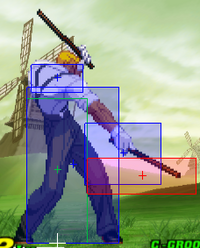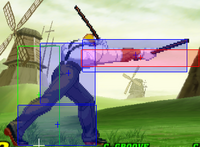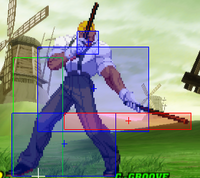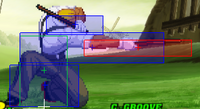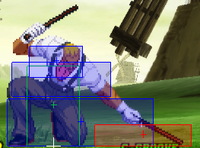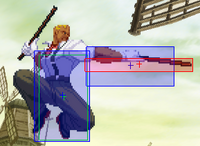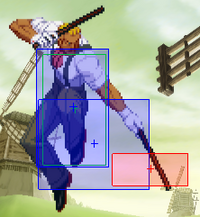JtheSaltyy (talk | contribs) No edit summary |
JtheSaltyy (talk | contribs) No edit summary |
||
| Line 21: | Line 21: | ||
{{FP Box|header={{Big|'''Neutral'''}}|content= | {{FP Box|header={{Big|'''Neutral'''}}|content= | ||
<center>Eagle's main strength is in his footsies game, as he has a decent bunch of good pokes, most of them have good range and safety, while others provide great reward while being risky to throw out.</center> | |||
<br> | |||
<center>{{Big|'''5MK'''}}</center> | |||
[[File:CVS2 Eagle 5MK.png|200px|thumb|center]] | |||
<center>A strong counterpoke, great to use when you are expecting someone to throw out a poke and you throw this out in retaliation. It beats a lot of stuff, but the short range makes it a little hard to use as an actual poke.</center> | |||
<br> | |||
<center>{{Big|'''5HP'''}}</center> | |||
[[File:CVS2 Eagle 5HP.png|200px|thumb|center]] | |||
<center>Fantastic range, but is incredibly unsafe. Mainly used as a whiff punish due to its reach, as using it raw carries a ton of risk. When using it raw, it is extremely important to use in moderation, as a savvy opponent will blow up Eagle for being predictable with this button. If used correctly, however, it becomes an amazing move to use every now and then.</center> | |||
<br> | |||
<center>{{Big|'''5HK'''}}</center> | |||
[[File:CVS2 Eagle 5HK.png|200px|thumb|center]] | |||
<center>Essentially a less risky 5HP. Has a more favorable hitbox, but is also still very unsafe and has less range. Best used as whiff punish like 5HP, but also can be used as a counterpoke every now and then.</center> | |||
<br> | |||
<center>{{Big|'''2MP'''}}</center> | |||
[[File:CVS2 Eagle 2MP2.png|200px|thumb|center]] | |||
<center>Safe with long reach, leaves the opponent quite far from you which is nice if you are playing defensively. It is important to use this poke at a certain spacing such that either the 1st and 2nd hit connect, or just the 2nd hit connects. If just the 1st hit connects, you are extremely unsafe and open to a free punish. Mainly used as a raw poke such that the 2nd hit connects.</center> | |||
<br> | |||
<center>{{Big|'''2MK'''}}</center> | |||
[[File:CVS2 Eagle 2MK.png|200px|thumb|center]] | |||
<center>Used in a similar vein to Bison 2MK, you just throw it out there every now and then. Best used at midrange where whiffing it won't incur any horrible whiff punishes and you can check low pokes easily (Ryu 2MK, Cammy 2MK, Guile 2MK, etc). Sometimes used as whiff punish into super.</center> | |||
<br> | |||
<center>{{Big|'''2HK'''}}</center> | |||
[[File:CVS2 Eagle 2HK.png|200px|thumb|center]] | |||
<center>Basically 5HP but it has even more range and gives you a knockdown. In some aspects, it is better than 5HP in recovery, frame advantage, and reward, but keep in mind that this is a sweep, so it is very easy to jump over it, whereas with 5HP most pre-jumps will get clipped. Each have their time to shine. If the opponent is "dancing" in neutral and isn't respecting the threat of this sweep, throw it out. It will get them second guessing their movement and you can have more freedom to throw out your pokes and have general screen control. Another high risk high reward button.</center> | |||
<br> | |||
<center>{{Big|'''Short Hop j.MP'''}}</center> | |||
[[File:CVS2 Eagle jMP.png|200px|thumb|center]] | |||
<center>Shorthop Eagle is very uncommon, but if you find yourself playing him, this is a very good poke, almost as good as his other high range buttons. j.MP is already a fantastic button, but now you can use it at a height where it can actually be a decent poke. Best used at the tip to catch any attempted anti airs. Very easy to be crouched under.</center> | |||
<br> | |||
<center>{{Big|'''Short Hop j.MK'''}}</center> | |||
[[File:CVS2 Eagle jMK.png|200px|thumb|center]] | |||
<center>Trades range for being able to hit all characters. Can still be used at around cr.MP range, just make sure that it doesn't whiff otherwise the opponent can easily whiff punish, as the lower range means you'll be in the optimal range of many characters' low pokes.</center> | |||
<br> | |||
}} | }} | ||
| Line 45: | Line 78: | ||
Placeholder | Placeholder | ||
<br><br> | <br><br> | ||
== Vs. | == Vs. Eagle == | ||
Placeholder | Placeholder | ||
<br><br> | <br><br> | ||
| Line 81: | Line 114: | ||
<div class="mw-collapsible mw-collapsed" style="width:100%" > | <div class="mw-collapsible mw-collapsed" style="width:100%" > | ||
<div class="mw-collapsible-content"> | <div class="mw-collapsible-content"> | ||
For rolling, it is very important to | For rolling, it is very important to gauge the distance where the opponent likes rolling, and the actual distance of the roll itself. If an opponent plays Iori you're going to want to expect a roll from farther a way, whereas if someone plays King, you'd expect that roll more up close since it does not travel nearly as far. It is largely a test of reads and reactions, you have to know when your opponent likes to roll, but the character's roll can also give you a clue as to when to expect it. | ||
If you do get a read, what are your punishes? Well if they're close, you throw them, pretty simple. Throws beat rolls and throws only work up close. When farther away and a throw might not be guaranteed, you want to stick to a normal with a lot of active frames. 2HP and 2MK are your go-to roll punish buttons. If meaty enough, 2HP can net you a combo, but 2MK not so much. Either can give you a super if you really want to tell the opponent that was a bad roll. | If you do get a read, what are your punishes? Well if they're close, you throw them, pretty simple. Throws beat rolls and throws only work up close. When farther away and a throw might not be guaranteed, you want to stick to a normal with a lot of active frames. 2HP and 2MK are your go-to roll punish buttons. If meaty enough, 2HP can net you a combo, but 2MK not so much. Either can give you a super if you really want to tell the opponent that was a bad roll. | ||
Revision as of 16:27, 10 February 2025
Strategy
Eagle is a character who constantly uses his buttons to deal damage, with some super confirms and throws in between. He rarely uses his specials for anything outside of combos. For an extremely button reliant character, his individual buttons are decent, but not at the level of power that the stronger characters have. Because of this, Eagle's neutral, anti air and pressure game have to be really well played and technically sound in order to pose a threat to a good player. Eagle poses more threats offensively in the CAP grooves as opposed to the SNK grooves, but both contain strong options and tools at Eagle's disposal.
General Strategy
Placeholder
Vs. Eagle
Placeholder
Groove Strategy
C-Eagle is a good character with a great set of tools at his disposal. Level 2 cancels give Eagle a great way to use his meter. As well, Eagle has great synergy with C in general, as he just has to use his pokes and try to keep the opponent away. Along with A, it is his best groove.
| Pros | Cons |
|
|
Playing 
C-Eagle is a decent character. It's his best groove alongside A. The main playstyle with C-Eagle is playing mostly defensive while prodding the opponent with his variable arsenal of pokes. He can push pressure via his great dash, and getting a level 2 combo is the best form of damage that C-Eagle can get in terms of efficiency and meterbuild afterwards. He doesn't have the best pressure, but an empty dash from Eagle still catches many off guard. Most of playing C-Eagle comes from just using his pokes and anti airs correctly. Make sure to learn his combos as well, since it will be the main source of Eagle's damage throughout the round.
Level 2 Cancels
Placeholder
Placeholder: Placeholder
General Strategy
Placeholder
Vs. 
Placeholder
Anti-Roll
Here is the general strategy vs. rolling as Eagle.
Click "Expand" to see the contents.
For rolling, it is very important to gauge the distance where the opponent likes rolling, and the actual distance of the roll itself. If an opponent plays Iori you're going to want to expect a roll from farther a way, whereas if someone plays King, you'd expect that roll more up close since it does not travel nearly as far. It is largely a test of reads and reactions, you have to know when your opponent likes to roll, but the character's roll can also give you a clue as to when to expect it.
If you do get a read, what are your punishes? Well if they're close, you throw them, pretty simple. Throws beat rolls and throws only work up close. When farther away and a throw might not be guaranteed, you want to stick to a normal with a lot of active frames. 2HP and 2MK are your go-to roll punish buttons. If meaty enough, 2HP can net you a combo, but 2MK not so much. Either can give you a super if you really want to tell the opponent that was a bad roll.
Anti-Roll Cancel
Here are the main strategies to fight against Roll Cancels as Eagle. These aren't going to cover every RC individually, however every RC in the game will be countered by at least one of these tactics.
Click "Expand" to see the contents.
- Roll/Dodge: Basically fighting fire with fire. Rolling against a roll cancel works against long RCs, examples include: Claw's Rolling Ball, Sakura's Fireball and Tatsumaki, Eagle's Sticks, Honda's Hands, Chun's Spinning Bird Kick (just hope she doesn't hit you from behind), Yamazaki's Snake Arms, etc. Dodging does not work nearly as well as rolling but it can get you out of sticky situations. It is horrible against fast RCs if you don't commit to a dodge attack as you are vulnerable to a quick throw.
- Throwing: RCs are invincible against everything against throws. Reversal RCs are not technically reversals as throws can beat them on wake-up and in other close-up scenarios. Use it if you are in range and suspect the opponent might try to surprise you with it. When the battle is face-to-face, you might want to stray away from other options since the opponent can do the same things to you.
- Get Out: Jump out of the attack. Works well against moves shown in the roll/dodge bullet point, however for specials that can actually anti-air like Honda's Hands or Yamazaki's Snake Arms, they might not work, however specials like Rock's Elbow and Eagle's Sticks will eat shit once you get out of their range. Not always a recommended tool but it is effective in the right scenario.
- Guard Cancel: Against moves that are difficult to get out of, especially in the corner (Honda RC Hands, Iori RC Rekka), you can spend a little on a guard cancel to get your turn back. This is also going to do wonders for your guard bar. If you aren't in a groove with a guard cancel (basically P or K) then this option won't be available and you have to try something else, most likely just parry or JD the best you can.
General Strategy
Placeholder
Placeholder
| Pros | Cons |
|
|
Playing 
Placeholder
If you want to see Eagle's Custom Combos, refer to the Combos Section
Vs. 
Placeholder
Anti-CC
- Blocked CC: If the A-Groove player either failed to link into or mix into a custom. They will usually do a long blockstring that will tear your guard bar apart. Now, if you are in a groove with Guard Cancel or Counter Movement, then that is great. Just dock them in the face with it if you have the resources. If you don't, then you will either have to hope there's a punishable gap, or in the case of the ShoSho, pray that they drop the custom and get a free punish. Because Sagat is a big guy, certain custom combo mixups are more effective on him as well, so you will have to be ready to block some really weird but true blockstrings. Blocking a CC kinda sucks since you don't really get an opportunity to punish unless you have the resources to Guard Cancel but if that's what has to happen then it's better to do that instead of eating it.
- Roll CC: Oldest trick in the book. Basically roll super but instead it's a CC. If you notice the opponent getting a little roll happy then try to avoid getting greedy and stick with your faster buttons. If they are getting roll happy close to you then throwing is also a great option. Buttons like 2HP can get rolled past and you might eat a custom, but if you simply play it safe and defensively, then you will most likely shut down this attempt.
- Wake-Up CC: Another old trick that catches a lot of players. Generally gets beaten by doing nothing on wakeup and promptly punishing afterwards, though note they still have i-frames after the super freeze so you can't hit them right afterwards. If they immediately attack with something unsafe then get away and punish. If they use something safe just try to run away as best as you can. The most important thing is hitting the opponent so they lose custom. They cannot block, so their best option of avoiding anything is jumping or rolling, and by that point they lost the i-frames to blow through your counterattack.
- Anti-Air Custom: This one is pretty simple. Just don't jump.
- Trip-Guard Custom: Custom Combos that are done by blowing through the jump-in then countering with a low attack that will hit. Most times A-Groove players go for tripguard customs as answers to jumps than actual anti-air customs, since they are a little more difficult to perform. To beat these, just do an empty jump. You will be able to guard whatever hits you on the ground. It's even better if you have a low jump and intend to bait the custom.
- Up Close Custom: Can work as a footsies tool and a mixup tool. Very hard to beat and can be mixed with pokes, throws, and empty movements. To stop this, it's best to not throw out any greedy, unnecessary moves. If the opponent senses you will do something that their CC can tag and follow up with, then it's best to stick to the fast buttons. As well, if they are doing it as an offensive mix-up tool, then you will have to just keep them out as best you can. Jumping is a decent option if they are right on you, but note they can still anti-air you. Rolling can also work, but it may get meatied if they see it in time, and throwing them is extremely risky but it can work.
- Jump-In Custom: Pretty much beats any anti-air in the game. Instead of anti-airing them, try to get out of the jump-in and either air-to-air them, or use 2MK/2HK to punish their lack of tripguard.
Anti-Roll
Here is the general strategy vs. rolling as Sagat.
Click "Expand" to see the contents.
For rolling, it is very important to guage the distance where the opponent likes rolling, and the actual distance of the roll itself. If an opponent plays Iori you're going to want to expect a roll from farther a way, whereas if someone plays King, you'd expect that roll more up close since it does not travel nearly as far. It is largely a test of reads and reactions, you have to know when your opponent likes to roll, but the character's roll can also give you a clue as to when to expect it.
If you do get a read, what are your punishes? Well if they're close, you throw them, pretty simple. Throws beat rolls and throws only work up close. When farther away and a throw might not be guaranteed, you want to stick to a normal with a lot of active frames. 2HP and 2MK are your go-to roll punish buttons. If meaty enough, 2HP can net you a combo, but 2MK not so much. Either can give you a super if you really want to tell the opponent that was a bad roll.
Anti-Roll Cancel
Here are the main strategies to fight against Roll Cancels as Sagat. These aren't going to cover every RC individually, however every RC in the game will be countered by at least one of these tactics.
Click "Expand" to see the contents.
- Roll/Dodge: Basically fighting fire with fire. Rolling against a roll cancel works against long RCs, examples include: Claw's Rolling Ball, Sakura's Fireball and Tatsumaki, Eagle's Sticks, Honda's Hands, Chun's Spinning Bird Kick (just hope she doesn't hit you from behind), Yamazaki's Snake Arms, etc. Dodging does not work nearly as well as rolling but it can get you out of sticky situations. It is horrible against fast RCs if you don't commit to a dodge attack as you are vulnerable to a quick throw.
- Throwing: RCs are invincible against everything against throws. Reversal RCs are not technically reversals as throws can beat them on wake-up and in other close-up scenarios. Use it if you are in range and suspect the opponent might try to surprise you with it. When the battle is face-to-face, you might want to stray away from other options since the opponent can do the same things to you.
- Get Out: Jump out of the attack. Works well against moves shown in the roll/dodge bullet point, however for specials that can actually anti-air like Honda's Hands or Yamazaki's Snake Arms, they might not work, however specials like Rock's Elbow and Eagle's Sticks will eat shit once you get out of their range. Not always a recommended tool but it is effective in the right scenario.
- Guard Cancel: Against moves that are difficult to get out of, especially in the corner (Honda RC Hands, Iori RC Rekka), you can spend a little on a guard cancel to get your turn back. This is also going to do wonders for your guard bar. If you aren't in a groove with a guard cancel (basically P or K) then this option won't be available and you have to try something else, most likely just parry or JD the best you can.
Placeholder
Placeholder
| Pros | Cons |
|
|
Playing 
Placeholder
Parry Punishes
Placeholder
Ground Parry vs. Grounded Opponent
Placeholder
Ground Parry vs. Aerial Opponent
Placeholder
Air Parry vs. Grounded Opponent
Placeholder
Air Parry vs. Aerial Opponent
Placeholder
General Strategy
Placeholder
Vs. 
Placeholder
Anti-Parry
Placeholder
General Strategy
Placeholder
Placeholder
| Pros | Cons |
|
|
Playing 
Placeholder
Power Charge
Here are some situations where you can power charge as Eagle.
Full-Screen: Placeholder
Knockdowns: Placeholder
Neutral: Placeholder
Dodge
Placeholder
Dodge Attacks
Here are how you can use Eagle's dodge attack.
Dodge Punch (5HP): Placeholder
Dodge Kick (5HK): Placeholder
Desperation
Placeholder
General Strategy
Placeholder
Vs. 
Placeholder
Anti-Dodge
Placeholder
Anti-Desperation
Placeholder
Placeholder
| Pros | Cons |
|
|
Playing 
Placeholder
Vs. 
Placeholder
Anti-Roll
Here is the general strategy vs. rolling as Sagat.
Click "Expand" to see the contents.
For rolling, it is very important to guage the distance where the opponent likes rolling, and the actual distance of the roll itself. If an opponent plays Iori you're going to want to expect a roll from farther a way, whereas if someone plays King, you'd expect that roll more up close since it does not travel nearly as far. It is largely a test of reads and reactions, you have to know when your opponent likes to roll, but the character's roll can also give you a clue as to when to expect it.
If you do get a read, what are your punishes? Well if they're close, you throw them, pretty simple. Throws beat rolls and throws only work up close. When farther away and a throw might not be guaranteed, you want to stick to a normal with a lot of active frames. 2HP and 2MK are your go-to roll punish buttons. If meaty enough, 2HP can net you a combo, but 2MK not so much. Either can give you a super if you really want to tell the opponent that was a bad roll.
Anti-Roll Cancel
Here are the main strategies to fight against Roll Cancels as Sagat. These aren't going to cover every RC individually, however every RC in the game will be countered by at least one of these tactics.
Click "Expand" to see the contents.
- Roll/Dodge: Basically fighting fire with fire. Rolling against a roll cancel works against long RCs, examples include: Claw's Rolling Ball, Sakura's Fireball and Tatsumaki, Eagle's Sticks, Honda's Hands, Chun's Spinning Bird Kick (just hope she doesn't hit you from behind), Yamazaki's Snake Arms, etc. Dodging does not work nearly as well as rolling but it can get you out of sticky situations. It is horrible against fast RCs if you don't commit to a dodge attack as you are vulnerable to a quick throw.
- Throwing: RCs are invincible against everything against throws. Reversal RCs are not technically reversals as throws can beat them on wake-up and in other close-up scenarios. Use it if you are in range and suspect the opponent might try to surprise you with it. When the battle is face-to-face, you might want to stray away from other options since the opponent can do the same things to you.
- Get Out: Jump out of the attack. Works well against moves shown in the roll/dodge bullet point, however for specials that can actually anti-air like Honda's Hands or Yamazaki's Snake Arms, they might not work, however specials like Rock's Elbow and Eagle's Sticks will eat shit once you get out of their range. Not always a recommended tool but it is effective in the right scenario.
- Guard Cancel: Against moves that are difficult to get out of, especially in the corner (Honda RC Hands, Iori RC Rekka), you can spend a little on a guard cancel to get your turn back. This is also going to do wonders for your guard bar. If you aren't in a groove with a guard cancel (basically P or K) then this option won't be available and you have to try something else, most likely just parry or JD the best you can.
Anti-Guard Cancel Roll
Placeholder
Placeholder
| Pros | Cons |
|
|
Playing 
Placeholder
Just Defend
Placeholder
Just Defend Frame Advantage Formula
Good to reference for your character to see what kind of returns they can have on a JD.
Click "Expand" to see the contents.
Formula
Adv = G - (Act + Rec)
Adv = New frame advantage estimate from a JD'd attack. G = Guard Stun. See Guard Stun Estimates. Act = Active Frames of the JD'd attack. Rec = Recovery Frames of the JD'd attack.
Guardstun Estimates
Light Normals: 10 Frames
Medium Normals: 14 ~ 16 Frames
Heavy Normals: 18 ~ 20 Frames
Special Moves: 19 ~ 21 Frames
Examples
Rugal 2LP = 10 Frames - (4 Act + 6 Rec) = +0 on JD (+5 Normally)
Eagle 5MK = 14 ~ 16 Frames - (6 Act + 16 Rec) = -6 ~ -8 on JD (+0 Normally)
Sagat 2HP = 18 ~ 20 Frames - (8 Act + 14 Rec) = -4 ~ -2 on JD (+2 Normally)
Rage
Placeholder
General Strategy
Placeholder
Vs. 
Placeholder
Anti-JD
Placeholder
Anti-Rage
Placeholder
